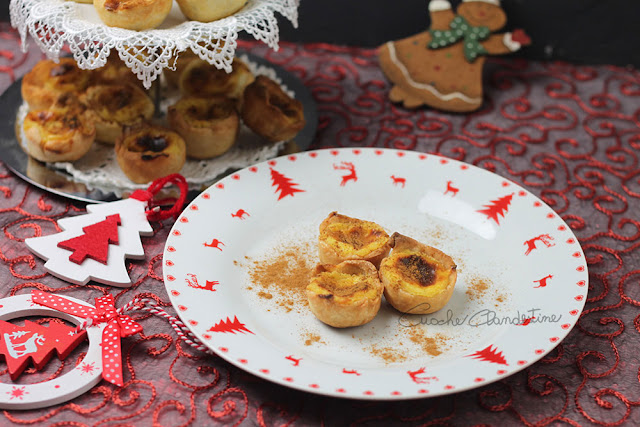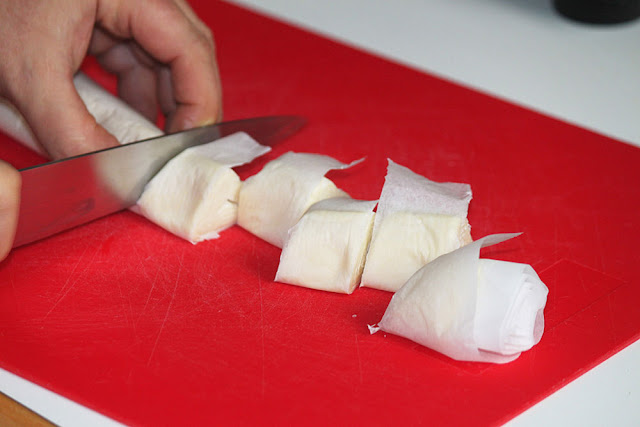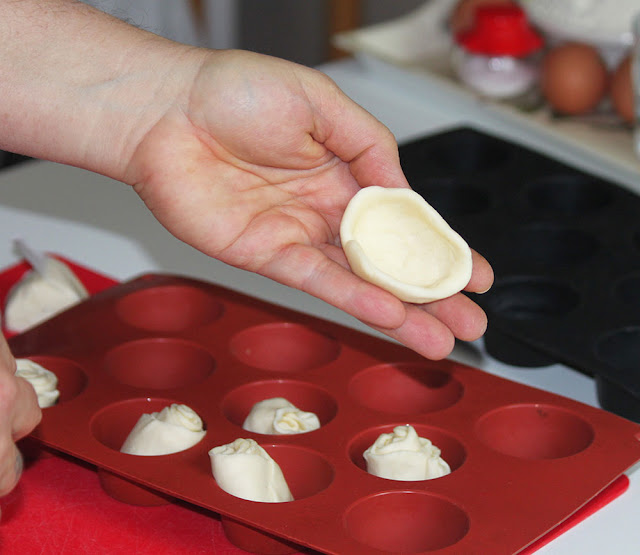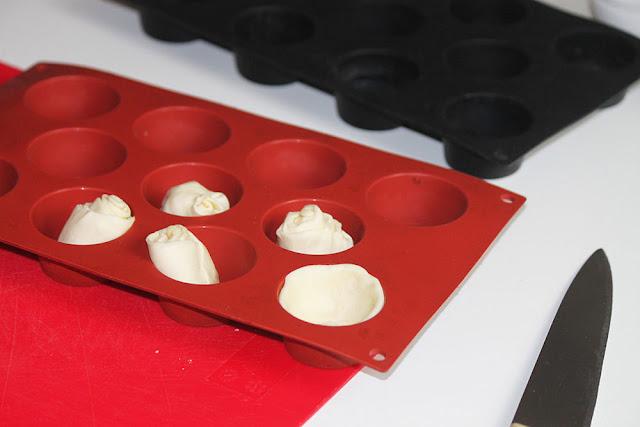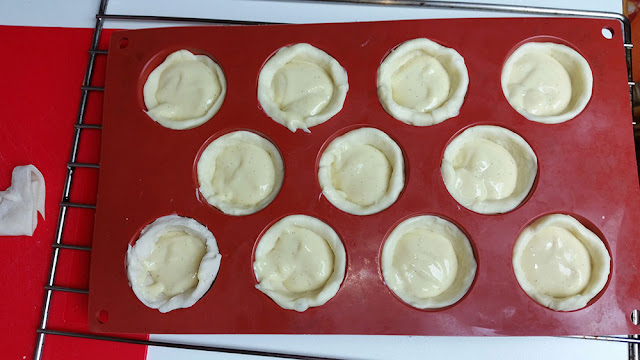Italiano. Una ricetta facile e anche veloce per questi deliziosi dolcetti di origine portoghese.
I Pasteis de nata (paste di crema) sono fatti di semplice pasta sfoglia (oggi facilmente reperibile al supermercato, già pronta) e una crema aromatizzata con limone, vaniglia e cannella.
La loro caratteristica è la bruciatura superficiale: non è un errore! Grazie alla particolare lavorazione (con i pollici delle mani) il contenitore di pasta sfoglia risulterà croccante mentre la crema sarà morbida e profumata. I Pasteis de nata che si gustano nelle pasticcerie portoghesi sono ben sfogliati, un po’ come l’involucro delle sfogliatelle napoletane, avete presente? Per ottenerle quella stratificazione bisognerebbe fare la pasta sfoglia dall’inzio e fare una lunga e difficile lavorazione… Noi non siamo pasticcieri e ci accontentiamo di questo risultato… che ne dite?
English. An easy and quick recipe to make these delicious small pastries coming from Portugal.
The Pasteis de nata (pastries filled with custard) are made by pastry and custard which can be flavoured with lemon zest, vanilla or cinnamon.
The top burning is their own detail: it is not a mistake! Working the folded pastry layers with the fingertips you will get a crunchy shell to fill with the scented custard.
The Pasteis de nata you can have in the Portuguese pastry shops are a bit different from ours: but making the original recipe with the pastry made from scratch is a real challenge, so we tried to make the recipe easier. And we are really pride with the result!
Español. Una receta fácil y rápida, para estos deliciosos dulces de origen portugués.
Los Pasteis de nata (pasteles de crema) están hechos de sencilla pasta de hojaldre (fácilmente disponibles en el supermercado ya lista) y una crema con sabor a limón, vainilla y canela.
Su característica es la superficie quemada: no es un error! Gracias a un proceso especial (con los pulgares) el recipiente de hojaldre serà crujiente mientras la crema será suave y fragante. Los Pasteis de nata que se prueban en las pastelerìas portuguesss son bien hojaldrados, un poco como la masa de hojaldre de las sfogliatella napolitana. Para obtener la estratificación deberìan hacer la masa de hojaldre desde el inicio, pero es un proceso largo y difícil … No somos pasteleros y estamos satisfechos con este resultado … ¿de acuerdo?
Italiano. I Pasteis de nata sono molto diffusi in ogni periodo dell’anno. Noi li proponiamo per Natale, ma in effetti sono facilissimi da fare e piuttosto veloci (in un’ora è tutto pronto) per cui ogni stagione è adatta per gustare questi dolcetti.
Noi abbiamo scelto un formato molto piccino, da finger food, per il quale ci siamo serviti dello stampo dei mini-muffin.
English. We are going to propose you the Pasteis de nata recipe for Christmas. Anyway every month of the year is right to have them as they are really easy and quick to prepare (they take almost one hour).
We made Pasteis de nata shaped as finger food, cooking them into a mini-muffin pan.
Español. Los Pasteis de nata se pueden encontrar todo el año. Nosotros los proponemos para la Navidad, pero en realidad son muy fáciles de hacer y muy rápido (en una hora todo está listo) por lo que cada temporada, es buena para degustar estos dulces.
Hemos elegido una medida muy pequeña, para finger food, para lo cual se utilizó el molde de mini-muffin.
Ingredienti per 30 dolcetti (diametro 3 cm)
(ingredients for 30 pasteis, diameter 3 cm – ingredientes para 30 pasteis de 3 cm de diametro):
- 200 g di panna fresca (200 g fresh cream - 200 g de nata fresca)
- 300 g di latte intero + qualche cucchiaio a parte (300 g whole milk + 3/4 tablespoons more - 300 g de leche + unas cucharadas màs)
- 100 g di zucchero (100 g caster sugar - 100 g de azùcar)
- 30 g di farina bianca (30 g plain flour - 30 g de harina blanca)
- 4 tuorli (4 egg yolks - 4 yemas)
- 1 stecca di vaniglia (1 vanilla pod - 1 baca de vainilla)
- buccia grattugiata di un limone (zest of 1 lemon - càscara rallada de un limòn)
- 500 g di pasta sfoglia arrotolata (500 g store-bought sheets pastry - 500 g de masa de hojaldre)
- cannella in polvere per spolverare (cinnamon powder to sprinkle - canela en polvo para espolvorear)
Italiano. Mettete in un pentolino la panna, il latte, lo zucchero e lasciate scaldare.
In una ciotola ponete le uova, la buccia di limone grattugiata e i semi della bacca di vaniglia. Sbattete leggermente. Sciogliete la farina in un po’ di latte, in modo che diventi liquida e senza grumi e aggiungetela alle uova sbattute.
Quando il latte è caldo, prima che inizi a bollire, versare il composto di uova nel latte girando continuamente con una frusta. Abbassate la fiamma e continuate sempre a girare con la frusta fino a quando la crema si addensa leggermente. La crema non diventerà soda del tutto, ma resterà molto morbida. Mettetela da parte ad intiepidire (coprite con pellicola).
English. In a large saucepan place the cream, the milk, the sugar and make it warm up.
In a large bowl put the egg yolks, the lemon zest, the vanilla seeds (scrape the seeds out of the vanilla pod). Lightly beat.
Place the flour into another bowl, add some milk (two or three tablespoons or more, one at a time) and mix to turn it into a liquid mixture (avoiding lumps). Add to the eggs mixture.
When the milk is warm (it’s better it does not boil) pour the eggs and flour mixture into the pan with milk and never stop stirring with a whisk.
Low the heat and go on stirring until the custard lightly thickens. It has to turn not into a sticky, firm mixture, but something like smooth one. Set aside to cool down (cover with clingfilm).
Español. Poner en una olla la nata, la leche, el azúcar y dejar que se caliente.
En un bol colocar los huevos, la ralladura de limón y las semillas de la baca de vainilla. Batir ligeramente. Disolver la harina en un poco de leche, de modo que se ponga líquida y sin grumos y añadir los huevos batidos.
Cuando la leche estè caliente, antes de que comience a hervir, verter los huevos en la leche, revolviendo constantemente con un batidor. Bajar la llama y seguir revolviendo hasta que la crema se espese ligeramente. La crema deeberò quedar casi lìquida y muy suave. Dejar enfriar (cubrir con pelìcula).
Italiano. Come pasta sfoglia noi abbiamo utilizzato due pacchi di sfoglia già pronta, acquistata al supermercato. Usate la pasta sfoglia ancora arrotolata e tagliate dei pezzi da 3 cm circa. Prendete ogni mucchietto di pasta fra le due mani: con i pollici spingete al centro in modo da creare un incavo.
Lavorate con le mani ben fredde la pasta a sua volta ben fredda di frigorifero.
English. Take the store-bought sheet pastry, roll them and cut in pieces of about 3 cm height each one. Take each roll and press the thumbs just in the middle to create a recess. You have to get a kind of small cup to fit the mini-muffin mold. Work with cold hands. Even the pastry has to be the coldest you can have.
Español. Cómo masa de hojaldre, hemos utilizado dos paquetes de masa de hojaldre lista, compradas en el supermercado. Utilice la masa de hojaldre todavía enrollada y cortar las piezas de aproximadamente 3 cm. Tome cada pieza de masa entre las dos manos: Con los pulgares, empuje el centro para crear un surco.
Trabajar muy bien con las manos frías la masa que a su vez debe de ser muy fría.
English. Go on this way until you run out of pastry. This method is suitable to get a crunchy and well stratified pastry cup. If you just cut a circle out of the pastry sheets, you get a thin shell with a fragile consistency. So that’s it why.
Español. Continúe hasta que toda la masa estè trabajada. Este procedimiento sirve para formar un contenedor bièn laminado para la crema. De esta manera se obtendrá una textura diferente y óptima.
Italiano. Appoggiare i cestini di pasta sfoglia in uno stampo da mini-muffin. Riempire a tre quarti
i cestini con la crema intiepidita.
Prima di mettere i Pasteis in forno, rimetteteli un po’ nel frigorifero a raffreddare: lo shock termico è fondamentale per un migliore risultato in cottura.
Infornare, infine, a 220°C in forno ventilato per circa 20 minuti o finché la crema risulterà bruciacchiata in superficie. Lasciare raffreddare i pasteis prima di consumarli. Servire con una spolverata di cannella.
English. Place the pastry cups into the mini-muffin molds. Fill with the cold custard until three/quarter of the height.
Before baking, fridge the pasteis for twenty minute at least: the thermic shock is needed for the best result of the recipe.
Then bake into pre-heated fan oven to 220°C for about 20 minutes or until you notice the surface is beginning to turn burnt.
Let the Pasteis cool down before having them. Sprinkle with ground cinnamon before serving.
Español. Apoyar las cestas de hojaldre en un molde de mini-muffin. Llenar las tres cuartas partes de las “cestas” con crema caliente.
Antes de poner los “Pasteis” en el horno, volver a ponerlos un poco en el refrigerador para enfriarlos: el choque térmico es esencial para un mejor resultado en la cocciòn.
Hornear a 220 ° C en un horno de convección durante unos 20 minutos o hasta que la crema empezarà a quemar en la superficie. Enfriar los Pasteis antes de consumirlos. Sirva con una pizca de canela.


